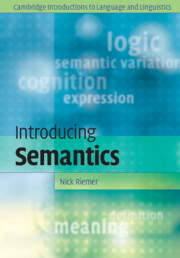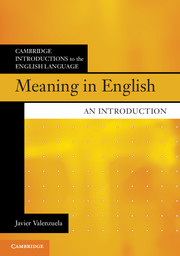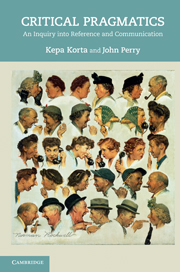Introducing Semantics
Semantics is the study of meaning in language. This clear and comprehensive textbook provides an introduction to the subject for undergraduate students. It not only equips students with the concepts they need in order to understand the main aspects of semantics, it also introduces the styles of reasoning and argument which characterise the field. It contains more than 200 exercises and discussion questions designed to test and deepen readers' understanding. More inclusive than other textbooks, it clearly explains and contrasts different theoretical approaches, summarises current debates, and provides helpful suggestions for further reading. Examples are drawn both from major world languages, such as Mandarin Chinese, Japanese, Arabic, Spanish and English, and from minority ones. The book also highlights the connections between semantics and the wider study of human language in psychology, anthropology, and linguistics itself.
- Includes more than 200 exercises and discussion questions to test and deepen understanding
- 'Inline' questions, interspersed throughout the text, encourage active participation in the development of key concepts
- Detailed chapter introductions and summaries make it easy for students to work through the text
Reviews & endorsements
'… an impressively wide - and relatively theory neutral - introduction to the field, whilst maintaining interest and clarity throughout. It is particularly strong in its use of cross-linguistic data from a wide variety of languages, which should appeal to those studying linguistics. Undergraduates will find it accessible and engaging, but there is also sufficient content to challenge more advanced students.' Bethan Davies, University of Leeds
'… an excellent introductory textbook for the instruction of meaning in language, presenting complex concepts in a clear but detailed fashion. It remains remarkably neutral without sacrificing rigor, and will be an extremely useful teaching tool given the correct setting.' The Linguist List
Product details
March 2010Paperback
9780521617413
473 pages
247 × 174 × 23 mm
0.97kg
27 b/w illus. 18 tables
Available
Table of Contents
- 1. Meaning in the empirical study of language
- 2. Meaning and definition
- 3. The scope of meaning I: external context
- 4. The scope of meaning II: interpersonal context
- 5. Analysing and distinguishing meanings
- 6. Logic as a representation of meaning
- 7. Meaning and cognition I: categorisation and cognitive semantics
- 8. Meaning and cognition II: formalising and simulating conceptual representations
- 9. Meaning and morphosyntax I: the semantics of grammatical categories
- 10. Meaning and morphosyntax II: verb meaning and argument structure
- 11. Semantic variation and change.






